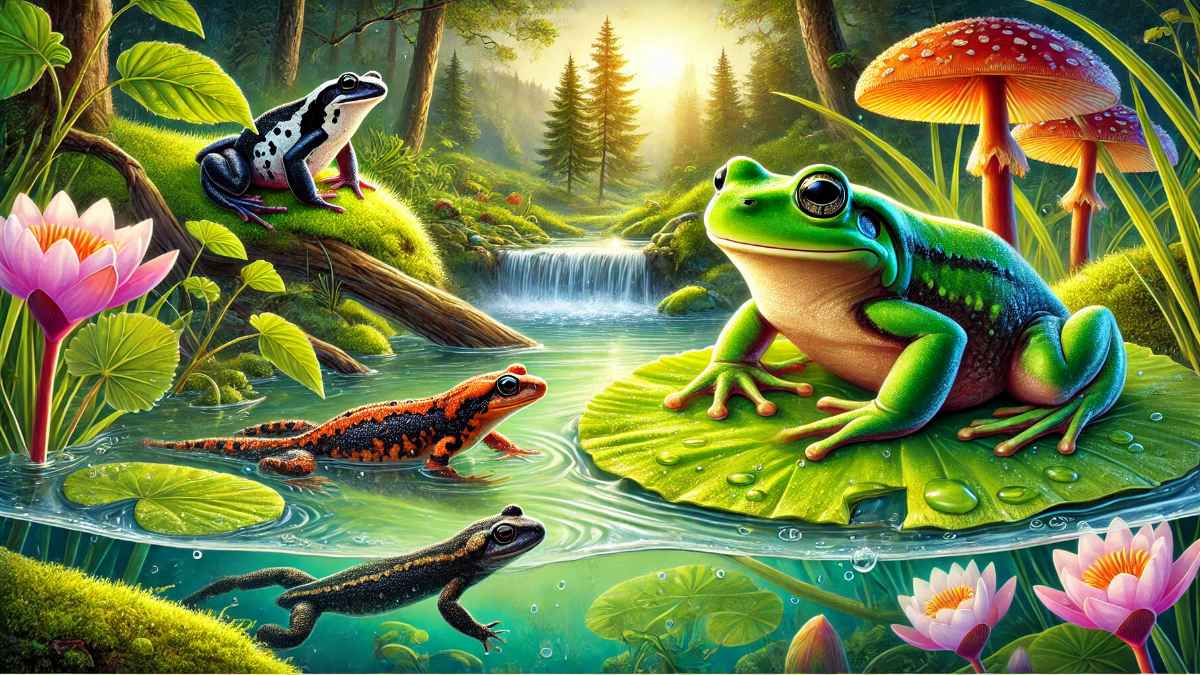Introduction
Amphibians are unique creatures that play a crucial role in the ecosystem. But what are the characteristics of an amphibian? These fascinating animals have distinct traits that separate them from reptiles, mammals, and birds. In this guide, we will explore the key characteristics of amphibians, their life cycle, habitat, and adaptations.
Key Characteristics of Amphibians
1. Dual Life (Amphibious Nature)
One of the defining traits of amphibians is their ability to live both on land and in water. Most amphibians start their lives in water and later develop the ability to survive on land.
2. Cold-Blooded (Ectothermic)
Amphibians rely on external sources to regulate their body temperature. Unlike warm-blooded animals, their body temperature fluctuates with the environment.
3. Moist, Permeable Skin
Their skin plays a vital role in respiration and water absorption. Amphibians do not have scales like reptiles but instead have smooth, glandular skin that keeps them hydrated.
4. Egg-Laying in Water
Most amphibians lay eggs in water, which hatch into larvae (like tadpoles) before undergoing metamorphosis into their adult form.
5. Metamorphosis
A unique feature of amphibians is their transformation from aquatic larvae to land-dwelling adults. This process includes significant changes in body structure and functions.
6. Respiration Through Skin, Gills, and Lungs
During different stages of life, amphibians breathe using gills (as larvae), lungs (as adults), and even through their skin.
7. Webbed Feet for Swimming
Many amphibians have webbed feet that help them swim efficiently in water.
8. Carnivorous Diet
Most amphibians are carnivorous, feeding on insects, worms, and small invertebrates.
9. Vocalization for Communication
Frogs and toads, for example, use calls and croaks to communicate, especially during mating seasons.
10. Sensitive to Environmental Changes
Amphibians serve as bioindicators, meaning their health reflects environmental conditions due to their sensitivity to pollution and habitat destruction.
Amphibian Habitat and Adaptations
Amphibians thrive in diverse environments, including forests, wetlands, and grasslands. They require moist surroundings to prevent dehydration. Some species have adapted to extreme conditions, such as burrowing underground during dry seasons.
Types of Amphibians
1. Frogs and Toads
- Most common amphibians
- Strong jumping legs
- Live near water sources
2. Salamanders and Newts
- Slender bodies with tails
- Prefer damp environments
- Regenerate lost limbs
3. Caecilians
- Legless, worm-like amphibians
- Burrow underground
- Found in tropical regions
Amphibian Life Cycle
- Egg Stage – Laid in water, soft and jelly-like.
- Larval Stage – Hatch into larvae (e.g., tadpoles) with gills.
- Metamorphosis – Develop legs, lungs, and lose gills.
- Adult Stage – Fully formed amphibians capable of living on land.

FAQ Section
1. What makes amphibians different from reptiles?
Amphibians have moist, permeable skin and undergo metamorphosis, while reptiles have scales and do not experience such transformations.
2. Do all amphibians live in water?
No, while most amphibians start their life in water, many adult amphibians live on land but require moist environments.
3. How do amphibians breathe?
Amphibians breathe through gills (as larvae), lungs (as adults), and their skin, which allows gas exchange.
4. Why are amphibians important to the ecosystem?
They help control insect populations and serve as bioindicators, signaling environmental health.
5. Can amphibians survive in extreme climates?
Some species have adapted to extreme conditions by burrowing underground or hibernating during dry or cold seasons.
6. Are all amphibians poisonous?
No, but some, like poison dart frogs, produce toxins to deter predators.
Conclusion
Amphibians are fascinating creatures with unique adaptations that allow them to thrive in both aquatic and terrestrial environments. Their life cycle, respiration methods, and sensitive skin make them essential for studying environmental changes. Understanding their characteristics helps us appreciate their role in nature and highlights the need for conservation efforts.

